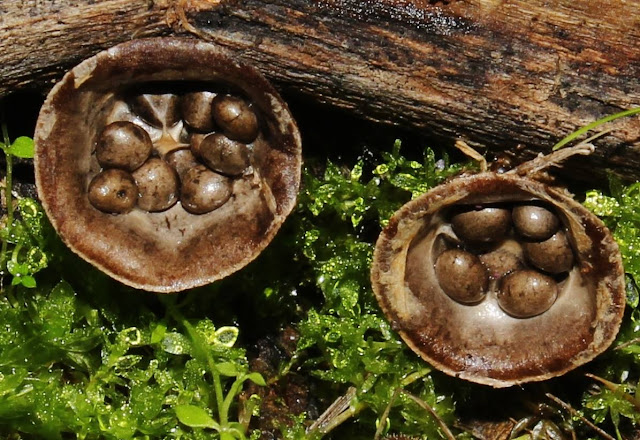

Cyathus olla bears a resemblance to a miniature bird's nest containing eggs, hence the common name bird's nest fungi. The fruiting body, or peridium, is roughly funnel-shaped, 10–18 mm tall and 8–12 mm wide. It is greyish yellow or greyish brown to fawn-colored and covered with even, fine-textured hairs on the outside surface. The inner surface is silver grey and smooth, often with faint transverse ridges. Cyathus olla is thick-walled, and flared outwards at the rim; the rim is typically wavy in outline. The 'eggs', or peridioles, typically number 8 to 10 in the cup, and they are white or grey in color, with a diameter of 2–4 mm—conspicuously larger than other Cyathus species. They are covered with a thin membrane called a tunica. Peridioles are often attached to the fruiting body by a funiculus, a structure of hyphae that is differentiated into three regions: the basal piece, which attaches it to the inner wall of the peridium, the middle piece, and an upper sheath, called the purse, connected to the lower surface of the peridiole. Inside the purse and middle piece is a coiled thread of interwoven hyphae called the funicular cord, attached at one end to the peridiole and at the other end to an entangled mass of hyphae called the hapteron. C. olla has a wide purse with an upper portion not easily distinguishable from the lower part.
A different form of this species, Cyathus olla forma anglicus, originally reported from England by mycologist Curtis Gates Lloyd, has also been found in Oregon and Colorado in the USA, Alberta Canada, and in Argentina. This form is large, with cup openings up to 1.5 cm (0.6 in) in diameter. Spores have dimensions of 11.5–12.5 × 7.5–9 µm.
The related species Cyathus earlei Lloyd closely resembles C. olla, although mating analysis has shown that they are distinct species.
Being a saprobic fungus, Cyathus olla obtains nutrients from the breakdown of dead organic matter, and as such is usually found growing on woody debris; specimens found growing on soil are usually attached to bits of wood or stems present in the soil. Brodie notes that this species usually grows in moist and shaded locations, although its discovery in the arid regions of Lima, Peru, suggest that it is tolerant of low-moisture conditions. It is the most abundant species of Cyathus found in Europe, and is also common in North America. Its range extends north to Sweden and far south in South America; it has also been reported in Australia, South Africa, Iran,and India..From Wikipedia, the free encyclopedia
Photos Athalassa 2/3/2010 by George Konstantinou




No comments:
Post a Comment